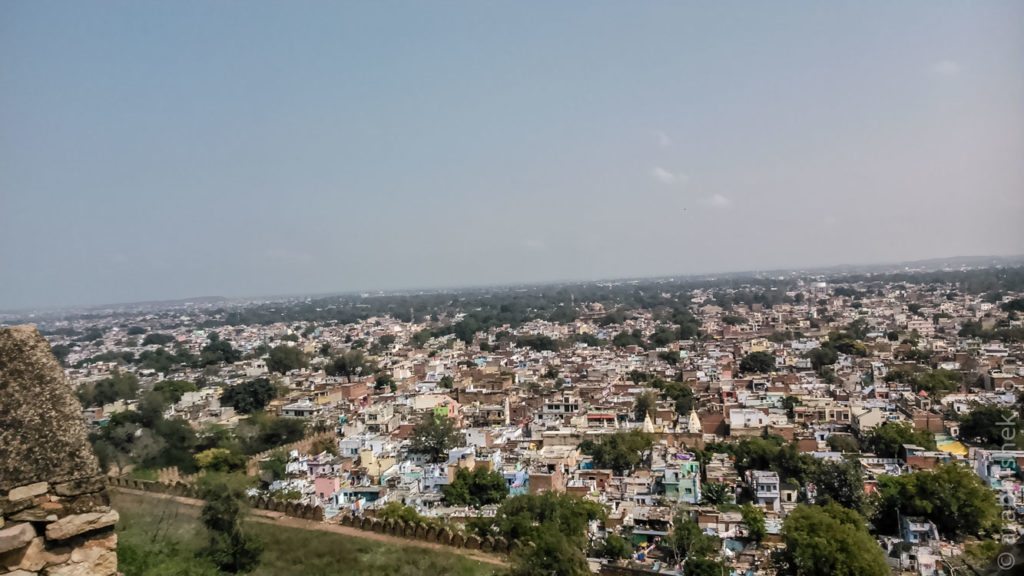Gwalior Fort…Visit to the Pearl of Fortresses
Gwalior fort is a majestic fort in the city of Gwalior on Gopachal Hill.It is believed that the fort was constructed by Suraj Sen in 3 AD who got cured of leprosy on meeting with a sage called Gwalipa on this hill.The sage gave him water from a nearby pond on the fort called Suraj Kund which cured him.
How to reach:-
Gwalior has easy connectivity from major places through Air,road and rail.Once reaching the city, private and shared vehicles are easily available for reaching to the fort.
It is situated on a flat top and isolated sandstone hill. It rises about three hundred feet above the town. The walls are about 30 to 35 feet height. The entrance to the Fort used to be protected by 6 Gates namely :-
- The Alamgiri Gate built my Muhtamad Khan , Governor of Gwalior in 1660.It is plain with a small courtyard inside and an open hall which was used to deliver Justice.
- The Badalgarh or Hindola gate which is a masterpiece of Hindu Architecture and was restored by Governor Saiyyad Alam in 1648.
- The Bhairon or Bansur gate constructed by one of the kachhwaha Rajas who had control of the fort some times ago.It does not exist now.
- The Ganesh gate was built by Dungar Singh in the first half of 15th century.
- Lakshman Gate almost halfway to the fort
- The Hathiya paur or Elephant Gate was built by Raja Man Singh and named such due to the carving of an elephant placed here.
There is also a Gujari Mahal near the Badalgarh gate.It was built by the king Raja Mansingh for his Gujari wife Mrignayani. She was a tribal woman with whom Raja fell in love and married .This was probably not liked by the other existing queens of Raja.Therefore,to keep things at peace, The Raja constructed a seperate palace outside the palace for her.Some stories also say that Mrignayani demanded a seperate palace for her with a water source from nearby river.
Today, Most of the people do not know the names of the existing queens,but Queen Gujari is known by all due to this palace.This palace measures about 300 feet by 230 feet and is two storeys high and built with hewn stone.It is now converted into a museum.
I entered through the north eastern part near the Gujari mahal which is closer to the old city and climbed my way upwards.The view of city became more and more beautiful as I moved upwards.

While you climb upwards to Fort from the eastern side, you will find some Hindu and Jain shrines constructed by carving into the hill.

On the way to entrance, you can find Chaturbhuj Temple which is an architectural masterpiece constructed in 876 AD.Here, you can find ‘Zero’ on the inscriptions which was believed to be the oldest inscription of Zero in the world. Recently, an even older one was found at Cambodia.

On entering the fort, I took the tickets from the ticket near the ASI Museum and opposite to the Man Singh Palace.The same ticket is valid for other monuments too.
There are five palaces inside the fort.The first one is the most marvellous and beautiful among others.It is called Man Singh Palace.Also called the chit Mandir or the painted palace,it was built in 1486-1516 and repaired in 1881.Its wall was once covered with beautiful coloured tiles,bands of mossaique candelabra,Brahmini ducks,elephant and peacocks-enamelled blue,green and gold making it look so elegant.Some of them are worn out now.This palace was praised by many kings and noblemen who visited it during the era.It is two storey high while another two storeys are constructed underground.

There is a viewpoint just near the Man Singh Palace where regular light and sound show is organised during the evenings.Tickets for the show are available near MP Tourism cafe, a few distance towards south side.The viewpoint provides magnificent view of the city and palace.


After the Man singh palace lies connected the Vikram palace also connected to adjoining Karan palace.The Karan palace ,also called Kirti Mandir, is long ,narrow and of two storeys.Beside it ,are the Jahangir and Shah Jahan palaces.


Near the Shah Jahan palace,is the Jouhar kund.Here, the Rajput women sacrificed themselves by jumping into fire before the fort was taken over during attack by Altamsh.Nearby is Chhatri of Bheem Singh Rana.

Near the Man Singh Palace is the ASI Museum which contains artifacts from in and around Gwalior.

Near the ASI museum lies the Assi Khamba Baoli, a large circular step-well.

Further South,are twin temples called Saas-bahu temple.The larger temple is supposed to be built by Raja Mahipal and is about 100 ft. by 63 ft.It stands on a richly carved plinth.There are four massive pillars inside the hall.

The smaller temple is in the form of a cross and open on all four sides.The body is about 23 sqft and supported on 12 pillars which are round with octagonal bases and bracketed capitals.

Going ahead, is the Teli ka mandir, constructed probably in 11th century.Earlier, it was a Vishnavite Temple, But from 15th century is a Shivite temple.

Furthest South is the Scindia School which has some notable alumni.

A doordarshan kendra also exists inside the fort.

Some other notable structures inside the fort are a Gurudwara, Suraj Kund,Some Jain Temples etc.Some Jain shrines are also carved out on the hills in groups on different sides of the hill.